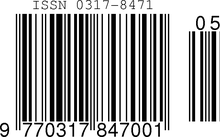Introduction and Code Format
- An ISSN is an eight-digit serial number used to uniquely identify a serial publication.
- It helps distinguish between serials with the same title.
- ISSNs are used in ordering, cataloging, and interlibrary loans.
- The ISSN system was first drafted as an ISO international standard in 1971.
- ISO subcommittee TC 46/SC 9 is responsible for maintaining the standard.
- An ISSN is an eight-digit code, divided by a hyphen into two four-digit numbers.
- The last digit is a check digit, uniquely representing the ISSN.
- The general form of the ISSN can be expressed as NNNN-NNNC.
- The check digit is calculated using a specific algorithm.
- The ISSN can be confirmed using an online ISSN checker.
Use in EANs
- ISSNs can be encoded in EAN-13 bar codes with a 977 country code.
- The main digits of the ISSN are included, followed by 2 publisher-defined digits.
- The EAN check digit may not match the ISSN check digit.
Code Assignment and Maintenance
- ISSN codes are assigned by ISSN National Centres coordinated by the ISSN International Centre.
- The International Centre is an intergovernmental organization created in 1974.
- The ISSN Register contains records for over 1,943,572 items.
- The Register is not freely available but can be accessed by subscription.
- ISSN codes are typically included in the print version of a serial and on serial websites.
Comparison with Other Identifiers
- ISSN and ISBN codes are similar in concept.
- ISBNs are assigned to individual books, while ISSNs are for serials.
- An ISSN is an anonymous identifier associated with a serial title.
- A new ISSN is assigned when a serial undergoes a major title change.
- Extensions like PII and SICI allow references to specific components of a serial.
Use in URNs and Problems
- An ISSN can be encoded as a URN by prefixing it with 'urn:ISSN:'.
- URN namespaces are case-sensitive, and the ISSN namespace is all caps.
- If the checksum digit is X, it is always encoded in uppercase in a URN.
- URNs need to point to unique content, unlike ISSN which may have multiple codes for the same journal.
- ISSN is not unique when the concept of a journal is a set of contents.
- The same journal may have two or more ISSN codes.
- The U.S. National Library of Medicine created the NLM Unique ID (JID) to address this issue.
- ISSN does not offer resolution mechanisms like DOI or URN.
- DOI is often used as a URN for articles.
Additional Group: Media category labels
- Two standard categories of media for serials: print and electronic.
- These categories may have standard labels in metadata contexts.
- Print ISSN (p-ISSN) is the ISSN for the print media version of a serial.
- Electronic ISSN (e-ISSN or eISSN) is the ISSN for the electronic media version of a serial.
Additional Group: ROAD
- ROAD: Directory of Open Access Scholarly Resources.
- Produced by the ISSN International Centre and UNESCO.
- Helps simplify the search, recovery, and delivery of data for various services.
- Particularly useful for search systems and knowledge databases.
- ISSN-L (Linking ISSN) was created to provide a unique URN for serials.
Additional Group: See also
- CODEN.
- WorldCat (ISSN-resolve service).
- References for further information on ISSN.
An International Standard Serial Number (ISSN) is an eight-digit serial number used to uniquely identify a serial publication, such as a magazine. The ISSN is especially helpful in distinguishing between serials with the same title. ISSNs are used in ordering, cataloging, interlibrary loans, and other practices in connection with serial literature.
 | |
| Acronym | ISSN |
|---|---|
| Organisation | ISSN International Centre |
| Introduced | 1976 |
| No. issued | > 2,500,000 |
| No. of digits | 8 |
| Check digit | Weighted sum |
| Example | 2049-3630 |
| Website | www |



The ISSN system was first drafted as an International Organization for Standardization (ISO) international standard in 1971 and published as ISO 3297 in 1975. ISO subcommittee TC 46/SC 9 is responsible for maintaining the standard.
When a serial with the same content is published in more than one media type, a different ISSN is assigned to each media type. For example, many serials are published both in print and electronic media. The ISSN system refers to these types as print ISSN (p-ISSN) and electronic ISSN (e-ISSN). Consequently, as defined in ISO 3297:2007, every serial in the ISSN system is also assigned a linking ISSN (ISSN-L), typically the same as the ISSN assigned to the serial in its first published medium, which links together all ISSNs assigned to the serial in every medium.